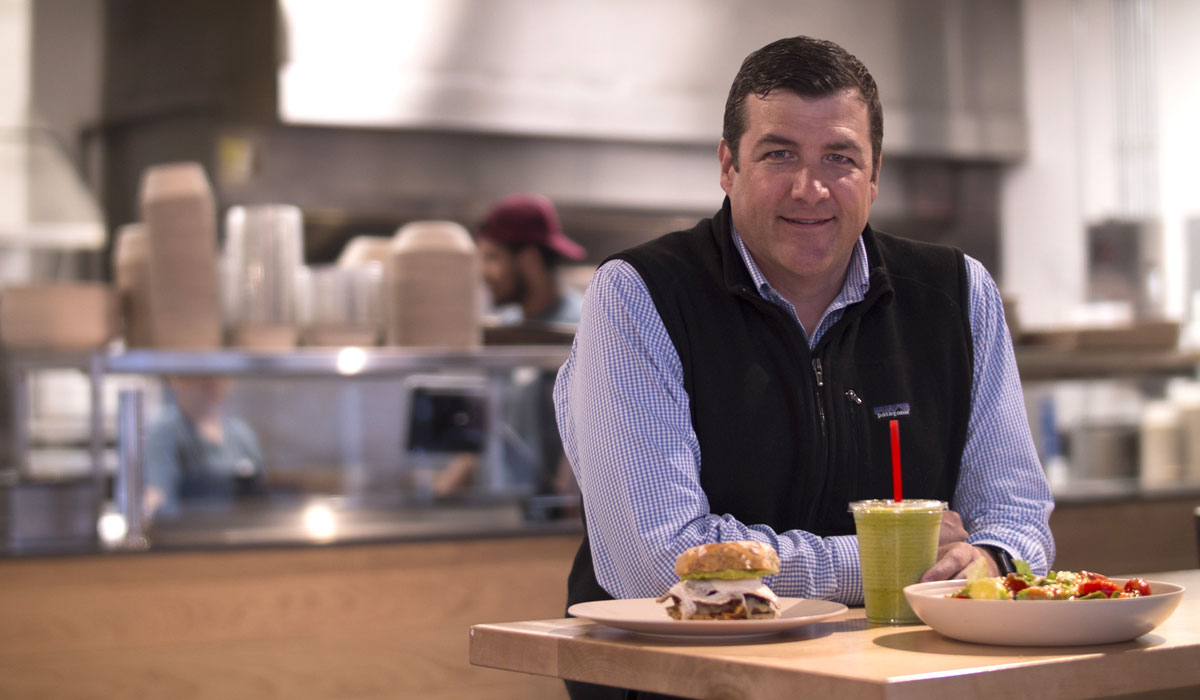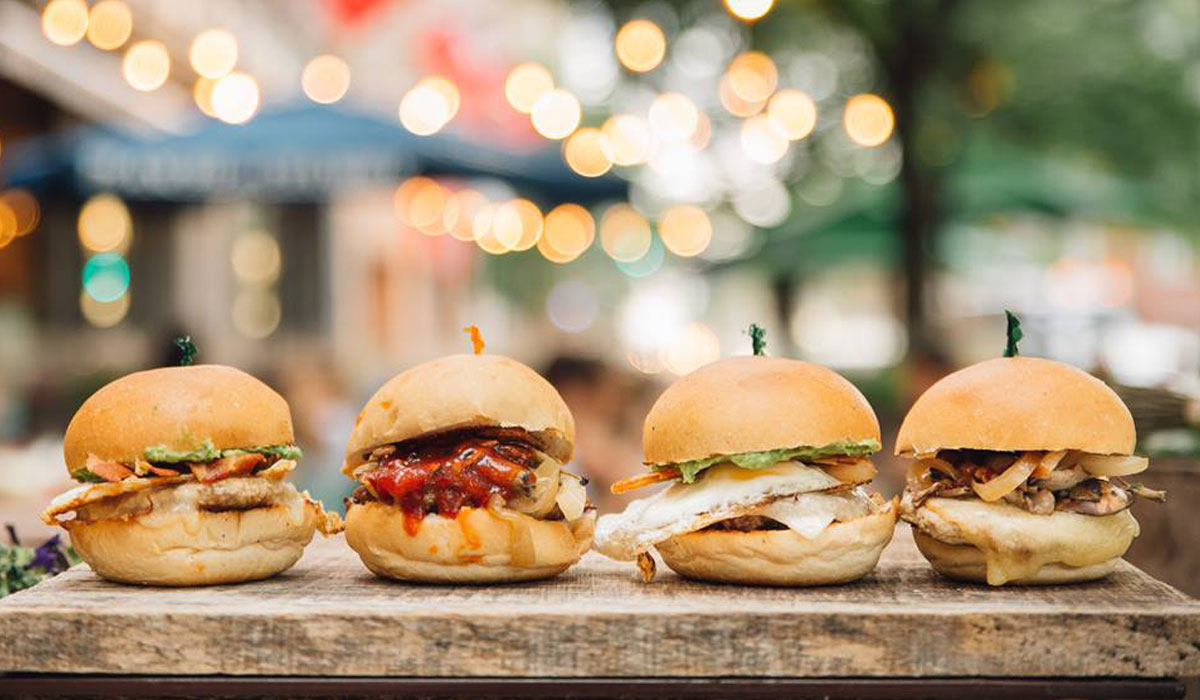One doesn’t need to look far to see Chris Fuqua’s Dunkin’ roots materializing at fast casual B.GOOD. Hired to lead the 77-unit chain last June, Fuqua arrived after nearly nine years with the coffee giant. He served in a variety of roles, including marketing, operations, supply chain, and strategy. And Fuqua was also part of what he calls a “pretty big menu simplification exercise.”
During Dunkin’s transformation over the past two years to a more beverage-led brand (goodbye Donuts in the name), it sliced 10 percent of its offerings. The goal, as always: take complexity out of restaurants and enable employees to deliver a better guest experience, improve order accuracy, drive operator profitability, and increase restaurant-level margins.
That’s been the blueprint, in many ways, for what’s unfolded at health-driven B.GOOD since Fuqua took over.
In this case, he says, it was less about the percentage of menu items cut, though, and more about making sure B.GOOD had the right items for the right consumer demographics. Overall the amount of SKUs removed falls in the 10–20 percent range. But B.GOOD didn’t simply clear space—it positioned itself for on-trend innovation going forward.
B.GOOD has rolled out two phases of menu changes in the last few months, including the introduction of a chicken-forward sandwich launch in mid-May and other changes to better meet its customers diverse dietary needs. The brand recently introduced a barbecue-focused lineup in June.
“We transferred some of that knowledge into what we’re doing at B.GOOD,” Fuqua says of his Dunkin’ experience.
It took some operational ticks from the java chain, a Dunkin’ strength in its recent growth push. B.GOOD looked at cross utilization of SKUs across the menus. It asked itself how many items were used in only one dish or menu item, and if it could deploy certain products across multiple offerings. B.GOOD examined the number of steps required to build a certain choice. “We knew that we wanted to stay chef inspired,” Fuqua says. “We didn’t want to go to a build-you-own kind of customer offering. We just wanted to reduce the number of steps per item so it could be easier to train the crew and it could be easier to prep.” It would also have a positive impact on B.GOOD’s cost of goods.

Next, B.GOOD simplified the look and feel of its menuboards so customers, especially first-time visitors, would have a better understanding of where they should start and what they should try. “It’s made our sales and service leaders more effective,” he says. “We think it’s going to improve the line and speed of service.”
The chain added kiosks in some stores. It took pricing from ending on the 9s to ending on the dollar or the 5s ($7.50 for instance).
But perhaps the biggest change in ordering behavior can be illustrated as follows: In the past, guests walked up to the cashier and were showered with options. Order the burger. What bun, cheese, protein would you like? It was a back and forth customers started to get a little frustrated with, Fuqua says.
Now, B.GOOD’s options are built. They’re still chef inspired and can be customized if needed, but they are designed offerings from top to bottom on the menuboard.
It’s critical to note, Fuqua says, how the simplification process provided room to grow and innovate instead of limiting it, as some cutbacks do. Especially as off-premises business accelerates and drives decisions into the kitchen. The chicken platform, for example, is one built to travel. And so are the bowls that often carry a seasonal choice, like the BBQ Chicken version with Stubb’s barbecue sauce featured recently.
All of the menu changes, however, are just one element of what boils down to a three-pronged strategy Fuqua has championed. It breaks down as menu, app and loyal, and off-premises upgrades.
B.GOOD shares another thread with Dunkin’ in regards to its potential. Much of the work taking place is designed to evolve the fast casual from a geographically centered cult brand into one capable of penetrating markets all over the map. Dunkin’ currently is focusing 90 percent of its 1,000 net new store target outside of the company’s Northeast stronghold.
B.GOOD’s footprint looks like this currently:
- Connecticut: 4
- Illinois: 4
- Maine: 2
- Massachusetts: 24
- New Hampshire: 2
- Virginia: 3
- New Jersey: 6
- New York: 6
- North Carolina: 9
- Pennsylvania: 1
- Rhode Island: 2
- Texas: 1
- Vermont: 1
- Canada: 5
- Germany: 3
- Switzerland: 5
Clearly, it jumps in one specific spot.
“I think we have a lot of work to do to transition us from a brand that was maybe geographically centered in New England into one that could move beyond the area and have the right systems and processes in place to expand and become something more interesting,” Fuqua says.
Since Fuqua joined, B.GOOD has opened 10 locations. Sixteen of the current 77 restaurants are franchises. Fuqua says the majority of B.GOOD’s future growth will come via franchising and the brand is engaged with partners up and down the Eastern seaboard. The company is targeting multi-unit operators looking to add a healthier option to their portfolio. Non-traditional has been effective, too, especially B.GOOD’s Boston Logan International Airport location, which opened in May.
“I know some brands have come out and said they’re not wild about third party and they’re not wild about what’s going on. I think if the brand doesn’t embrace it they’re going to be in a lot of trouble.” — Chris Fuqua, B.GOOD CEO.
Yet while the brand is nurturing a franchise pipeline, Fuqua says, his second year won’t be focused on ballooning B.GOOD’s unit count. “No. 1 will be making sure that we’re devising the best possible guest experience every day,” he says. “Really building that culture within the restaurants and giving them everything they need to make sure they’re successful. Then, expanding the brand and telling more people about what B.GOOD is all about.”
The off-premises opportunity is an interesting one at B.GOOD. In the early days of third-party delivery, the brand had a habit of turning the service off and on as it tried to grapple with the ramifications. B.GOOD wanted to be cutting edge but wasn’t sure of the margin effect, like many operators. Or how it might compromise its food or customer experience.
In the last 6–9 months, however, B.GOOD embraced the notion that third party is not going away, Fuqua says. So instead of constantly fighting the movement or debating its merits, B.GOOD decided to dive in. “I think with third party, the reality is customers are rapidly changing the way they interact with brand and the way they eat,” Fuqua says. “And we said this for a long time, but people want—this generation especially—wants what they want, when they want it, where they want it. And I think restaurants are going to have to embrace the idea that they’re going to have to get their food to people instead of always relying on people to come to them.”
How has B.GOOD done so? In a few ways, including working with aggregators that allow the brand to play with prices. Negotiate the fees down to a point where customers would be able to stomach the fee and B.GOOD can make sure sales are incremental, Fuqua says.
Also, looking at its menu for delivery and how it compares to dine-in service. The digital offerings remove some complex items. B.GOOD wants stores to have a clear pick-up point, too, intended for those guests who order through its app and want to pick up without interacting with employees. That’s important for the delivery drivers as well.
“I go around to various brands at different times and I think everybody is in a little bit different space here,” Fuqua says. “I know some brands have come out and said they’re not wild about third party and they’re not wild about what’s going on. I think if the brand doesn’t embrace it they’re going to be in a lot of trouble.”
“Finding ways to embrace it,” he adds. “Finding ways to improve it rather than shying away from it. I think that’s the only choice.”

B.GOOD has worked internally on what it calls catering 2.0 over the past year. The brand is up 40 percent in the offering, Fuqua says. This involves a catering staff that expands the service and focuses on finding ways to market to events looking for a healthier, different choice.
In early June, B.GOOD also partnered with virtual kitchen center Kitchen United’s River North spot in Chicago. This gave B.GOOD, which has three suburban locations, a chance to reach consumers working and living downtown. “… while Chicagoans are interested in the type of food we offer, a growing number of people, especially those based in urban areas like downtown are interested in getting it delivered fresh to their home or office,” Fuqua said at the time. “We want to meet our consumers where they are and best support their needs, and Kitchen United is helping us do just that.”
From an app and loyalty perspective, B.GOOD relaunched the platform with Punchh in late March. B.GOOD Rewards allows customers to earn and redeem through a straightforward points-based structure that gives one point for every dollar spent. There are flexible redemption tiers so guests can cash in at their own pace—in increments of 50, 75, and 100 points. This came with a newly launched app and online ordering system that added order-ahead capability, dietary filters, status tracking, and enhanced nutritional information into the functionality.
This was a big change for B.GOOD, Fuqua says, because it moved the brand away from a surprise-and-delight package into something stickier and more customizable. The past iteration was a hard sell. “It just wasn’t explainable to a customer,” Fuqua says. “And I’m a big believer that customers only participate in programs where they can understand why they’re getting the point, and then they’re respond.”
With a points-based program, B.GOOD can look at how many new users it gets and what they’re behavior is on a regular basis. It can then target specific groups with offers. Drive visitation with curated, point-based incentives.
“I can give points for two visits instead of one visit this week, or I can drive time-based visitation where if you come after a certain time of day I can give you a certain number of points,” Fuqua says.
“It’s just a currency that is really malleable and usable when you start collecting the data. You can understand more about your customers and you can hopefully end up driving different purchasing behavior or better purchasing behavior going forward.”





